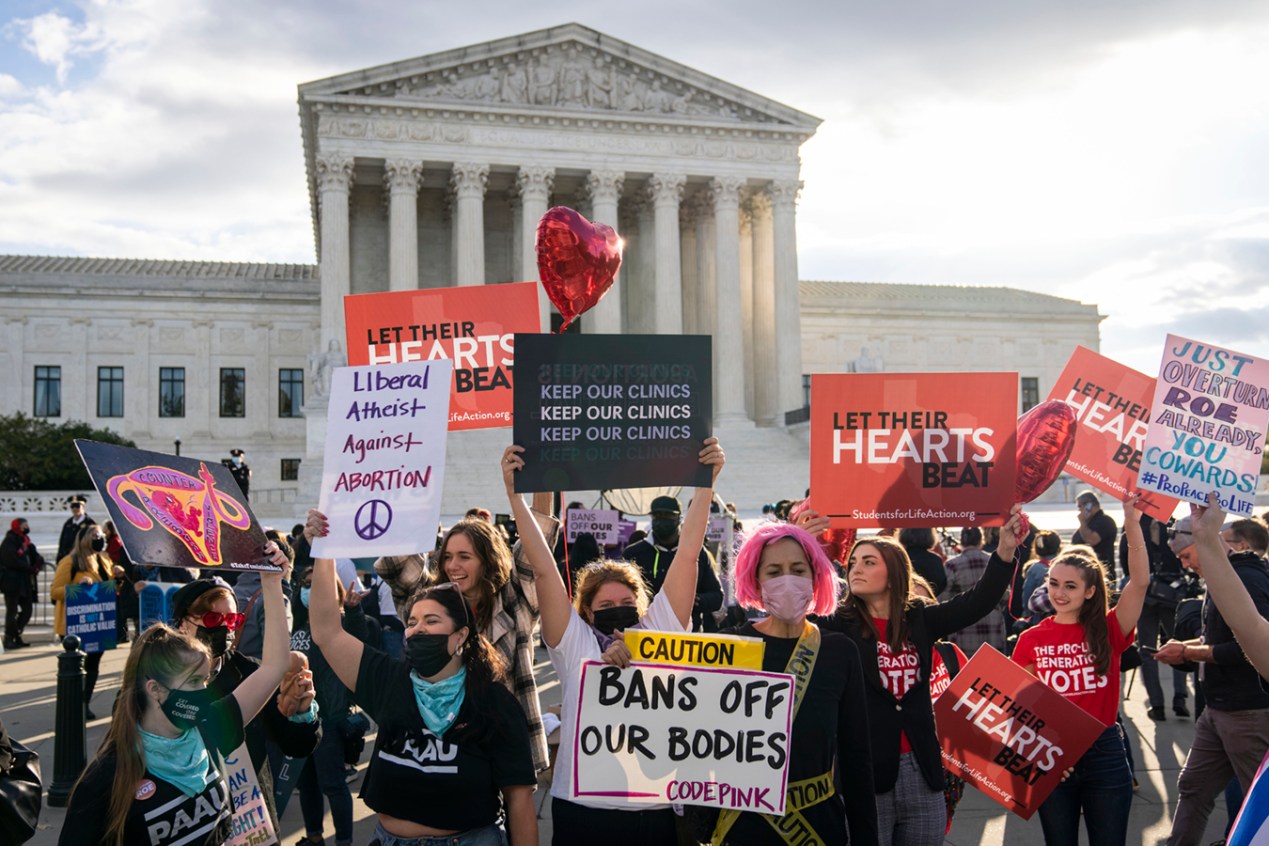The Supreme Court, whose conservative majority is considered poised to overturn decades-old decisions guaranteeing abortion rights, heard its first two abortion cases of the 2021-22 term Monday. But the court could decide this case without deciding the fate of abortion rights in America.
At stake is the future of a Texas law, which severely limits the procedure, that the high court refused to block from taking effect in September. The state law has cut the number of abortions in the state by half.
The Texas law — known as SB 8 — is similar to laws passed by several states over the past few years in that it bans abortion after fetal cardiac activity can be detected, which typically occurs about six weeks into pregnancy. That is in direct contravention of Supreme Court precedents in 1973’s Roe v. Wade and 1992’s Planned Parenthood of Southeastern Pennsylvania v. Casey, which say states cannot ban abortion until fetal “viability,” which is about 22 to 24 weeks. The law also makes no exception for pregnancies caused by rape or incest.
The Texas law, however, varies from other state “heartbeat” laws because it has a unique enforcement mechanism that gives state officials no role in ensuring that the ban is obeyed. Rather, it leaves enforcement to the general public, by authorizing civil suits against not just anyone who performs an abortion, but anyone who “aids and abets” the performance of an abortion, which could include those who drive patients to an abortion clinic or counsel them. Those who bring suits and win would be guaranteed damages of at least $10,000. Opponents of the law call that a “bounty” to encourage individuals to sue their neighbors.
Supporters of the law have said it was specifically designed to prevent federal courts from blocking the law since no state officials are involved in enforcement and therefore not responsible for it.
It is that enforcement mechanism that the Supreme Court considered during three hours of arguments Monday. The first case, Whole Woman’s Health et al. v. Jackson et al., was brought by a group of abortion providers, the second, U.S. v. Texas et al., by the Justice Department. The question before the justices was not directly whether the Texas ban is unconstitutional, but whether either the abortion providers or the federal government can challenge it in court.
Marc Hearron of the Center for Reproductive Rights, who represented the abortion providers, said the Texas law, if upheld, could influence far more than abortion. “To allow the Texas scheme to stand would provide a road map for other states to abrogate any decision of this court with which they disagree,” he told the justices.
U.S. Solicitor General Elizabeth Prelogar, in her first appearance before the court in that role, expressed similar sentiments, calling the Texas law “a brazen attack” on the other branches of government. States, she said, “are not free to place themselves above this court, nullify the court’s decisions and their borders, and block the judicial review necessary to vindicate federal rights.”
But Texas Solicitor General Judd Stone insisted that neither case should be allowed to proceed and that any legal actions should be handled by state courts. What both sets of plaintiffs want, he said “is an injunction against the law itself. But federal courts don’t enjoin state laws, they enjoin officials.” And because of the unique way the law was crafted, Texas officials are not involved in the law’s enforcement.
At least a few members of the court’s conservative majority, notably Justices Amy Coney Barrett and Brett Kavanaugh, seemed at least somewhat dubious about whether Texas could evade all federal court review and what that could mean for issues other than abortion. Several justices cited a “friend of the court” brief filed by a gun rights group that sided with the abortion providers, not because it agreed with the position on abortion, but because the group wrote “that the judicial review of restrictions on established constitutional rights, especially those protected under this Court’s cases, cannot be circumvented in the manner used by Texas.”
That was a point made repeatedly by the liberal-leaning justices, who have made it clear they oppose the Texas law. “Essentially, we would be inviting states, all 50 of them, with respect to their un-preferred constitutional rights, to try to nullify the law … that this Court has laid down as to the content of those rights,” said Justice Elena Kagan. “I mean, that was something that until this law came along no state dreamed of doing.”
The court has already demonstrated its division over the law when it voted 5-4 in September to allow it to take effect. Barrett and Kavanaugh were among the majority in that vote. The court also refused to block the law when it accepted the current case 10 days ago.
Typically, in major cases like this, decisions come at the end of the court term, which would be next spring or summer. However, this case was considered on the court’s “rocket docket,” in the fastest consideration of a case since the justices decided who should become president in 2000’s Bush v. Gore.
Another complication is that the court is scheduled to hear arguments next month in a separate Mississippi case in which they will consider the future of abortion rights. That case, Dobbs v. Jackson Women’s Health Organization, challenges a law that seeks to ban abortions after 15 weeks of gestation. The court has agreed in that case to consider whether states can ban abortion prior to viability.
The Texas case could be decided before the Mississippi case is heard, or after, or the cases could be decided together.







